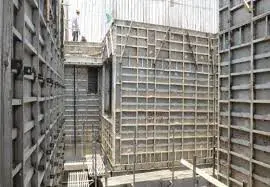Mivan formwork is basically an aluminium formwork system. Mivan formwork is a rapid pace construction technique, offering speed without deteriorating strength or durability.
Mivan formwork is an advanced and unique construction technique in which concrete can be poured for wall with roof in single site operation, without compromising with accuracy in shape and size of the structure.
An extruded aluminium rail section welded to aluminium sheet constitutes the basic element of mivan formwork. This forms a lightweight panel with an optimum stiffness to weight ratio and thus, yields minimum deflection during concrete loading.

Where is Mivan Formwork Used?
It is mostly used in Europe, Gulf countries and Asia due to increasing population demand, especially for mass housing projects.
As of now, this technique has not been used extensively in India. However, it is being highly promoted for an ambitious Govt. Scheme – “Housing for All by 2022”, as with use of mivan technique, a huge number of houses can be constructed for a large number of population within short period and economically.
Advantages and Disadvantages of Mivan Formwork
Advantages of Mivan Formwork
- Mivan formwork is light in weight so, it can be handled easily
- As it has a fixed set of procedure its installation doesn’t require any skilled labour
- Superior quality is obtained due to casting of whole structural components together, resulting into monolithic construction
- More resistant to seismic forces
- Rapid pace/ High construction speed due to which whole construction is completed in less duration, making this technique economically sound by reducing indirect costs of project
- Lower maintenance required as the number of joints is less
- Efficient in terms of plinth area usage
- Provides a natural aesthetics as the surfaces formed are smooth. Further, no requirement of plastering
- Formwork panel can be used as much as 200 times
- Aluminium does not have corrosion problem such as steel
- Less fabrication cost and correspondingly less debris generation
Disadvantages of Mivan Formwork
- Very less or in fact, no scope for future modifications and alterations
- The shear walls may cause higher generation of heat of hydration
- Contraction cracks are major problem for mivan formwork
- To be cost effective, mivan formwork requires uniform panelling and elevations. It proves to be economical mostly in case of symmetrical structures
- Small or limited thickness of components makes it difficult to work in concealed locations
- Its initial cost is high as aluminium formwork is expensive and initial setup is also time taking. Moreover, continuous supervision is required to maintain required alignment
- Holes formed by wall ties should be grouted properly else there might be leakage problem
- The finished surfaces might have visible finishing lines as the components used are of small size

Comparison Between Mivan and Conventional Formwork
| PARAMETER | CONVENTINAL FORMWORK | MIVAN FORMWORK |
|---|---|---|
| Quality | Conventional formwork provides normal quality structural members. | Mivan formwork provid es superior quality due to monolithic casting of structural members as casting is done in continuous operation. |
| Construction speed / work pace | Speed of construction is very slow while using conventional formwork due to step by step construction. | While using mivan formwork concrete can be poured for wall with roof in single site operation and thus, increasing pace of work. |
| Cost with respect to total project cost | Conventional formwork costs about (10 to 15) % of total project cost. | Mivan formwork can cost up to (20 to 25) % of total cost of project. |
| Future modifications | Future alterations were easily possible while conventional formwork were in use. | If mivan formwork is used, future changes are difficult, in fact not possible in most cases. |
| Maintenance cost | Maintenance cost is high in case of conventional formwork, due to damages caused. | In case of mivan formwork, maintenance cost is least or say, negligible. |
| Plinth area usage | Conventional formwork has lower efficiency than mivan formwork, in terms of plinth area usage. | Mivan formwork results into approximately 87.5% efficiency. This might be due to thin shear wall. |
| Ease to carry | Various conventional formwork such as wooden or steel formwork are difficult to carry due to their heavy weight. | Mivan formwork is very lightweight and quite easy to carry. |
| Resistant to seismic forces | Comparatively lower resistant to seismic forces. | Structures formed by using mivan formwork are comparatively more resistant to seismic forces. |
| Durability | Lower | Higher |
| Miscellaneous problems such as leakage and moisture absorption. | Conventional formwork faces various unwanted problems such as, leakage and absorption of water in wooden formwork, corrosion in steel formwork, etc. | Mivan formwork is totally free from such issues. |
– Tushar Meena





